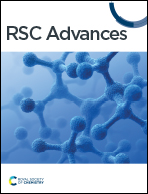In situ one step growth of amorphous tin oxide electron transport layer for high-performance perovskite solar cells†
Abstract
Tin oxide used in electron transport layer (ETL) exhibits key role in transmitting electrons and blocking holes in perovskite solar cells (PSCs) device. However, crystal tin oxide nanoparticles (NPs) become necessary to form SnO2 film by method of spin-coating, resulting in possible surface defect and cracks among SnO2 NPs, corresponding to unsatisfied performance PSCs. Herein, an amorphous tin oxide thin film is creatively in situ grew onto Fluorine-doped Tin Oxide (FTO) substrate as ETL. The designed solar cell device with structure of FTO/SnO2/MAPbI3/Sprio-OMeTAD/Ag owns a champion photoelectric conversion efficiency (PCE) up to 17.64%, 76.20% of filling coefficient (FF), and 1.09 V of open-circuit voltage (Voc), in comparing with 16.43%, 64.35% and 1.05 V for control group (crystal tin oxide as ETL), respectively. Besides, the champion device keeps 83.33% of initial PCE under nitrogen (N2) condition for one month, in comparison with 76.09% for control group. This work provides a viable strategy for facile preparing amorphous tin oxide film based ETL in perovskite solar cells.



 Please wait while we load your content...
Please wait while we load your content...